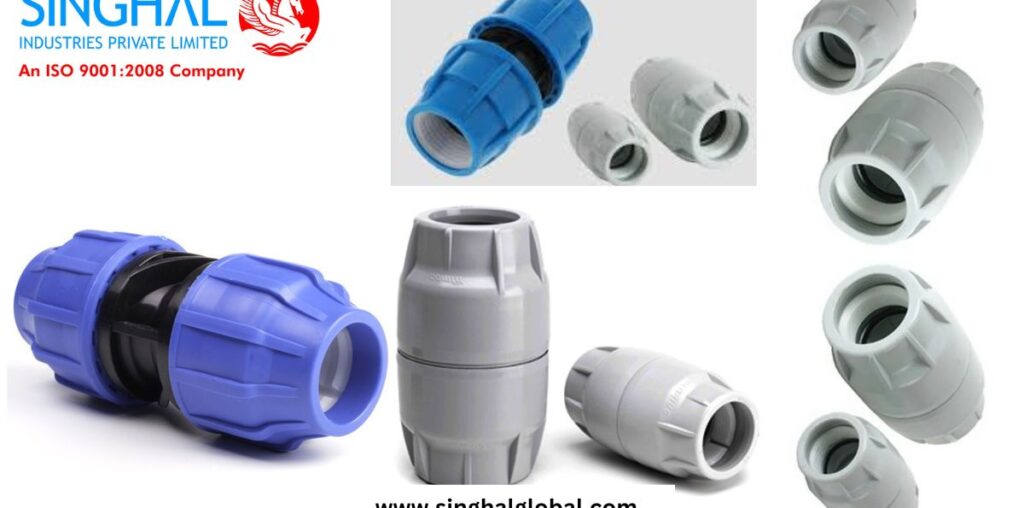HDPE (High-Density Polyethylene) duct couplers are integral components in the construction of underground piping systems, particularly in telecommunications, electrical, and utility sectors. These fittings are used to join sections of HDPE ducting, ensuring a reliable and durable connection for the efficient passage of cables, fibers, and other essential infrastructure. The rising demand for reliable, long-lasting connections in underground conduit systems has led to an increased focus on HDPE duct coupler fittings, which are essential for ensuring the strength and stability of these networks. In this article, we’ll explore the advantages of HDPE duct couplers, what to look for when selecting an HDPE duct coupler manufacturer, and how these fittings contribute to the overall success of modern infrastructure projects.
What are HDPE Duct Couplers?
HDPE duct coupler fittings are specialized devices used to connect two sections of HDPE piping or ducting. These couplers are typically made from high-density polyethylene (HDPE), a material known for its resistance to chemicals, corrosion, and environmental stress. HDPE duct couplers are designed to provide a strong, secure, and waterproof joint between sections of duct, preventing the entry of contaminants and ensuring the safe and uninterrupted flow of cables or fibers.
These couplers are widely used in a variety of industries, including telecommunications, power, and water utilities, to maintain the integrity of underground cable systems. By using HDPE duct couplers, companies can ensure that their infrastructure remains operational and secure for decades, with minimal maintenance.
Advantages of HDPE Duct Couplers
- Durability and Longevity
One of the key benefits of HDPE duct couplers is their impressive durability. HDPE is a robust material that can withstand harsh environmental conditions such as extreme temperatures, moisture, and physical stress. This makes HDPE duct couplers ideal for underground applications, where they will be exposed to soil pressure, water, and potential impacts. The long-lasting nature of these fittings ensures that they provide a reliable connection throughout the lifespan of the ducting system. - Corrosion and Chemical Resistance
Unlike traditional metal fittings, HDPE duct couplers are highly resistant to corrosion and chemicals. They do not degrade when exposed to water, oil, or other corrosive materials, making them perfect for use in harsh or volatile environments. This resistance significantly reduces the likelihood of leaks or damage to the ducting system over time, minimizing maintenance costs. - Flexibility and Ease of Installation
HDPE duct couplers are designed for easy and quick installation. They are lightweight, which simplifies transportation and handling. Additionally, their flexibility allows them to absorb movement or settling of the ground without compromising the connection. This flexibility makes them suitable for a wide range of applications, including those in seismic or shifting soil environments. - Environmental Sustainability
HDPE duct coupler fittings are environmentally friendly as they are made from a recyclable material. This makes them an excellent choice for eco-conscious businesses and infrastructure projects. In addition to being recyclable, HDPE products contribute to the sustainability of projects by providing a long-lasting solution that reduces the need for frequent replacements. - Waterproof Seals
HDPE duct couplers are designed to provide waterproof seals between sections of ducting. This is crucial for preventing the ingress of moisture into the conduit, which could potentially damage the cables or fibers inside. The tight, leak-free connection ensures that the system remains protected from environmental factors like groundwater or rain.
Selecting an HDPE Duct Coupler Manufacturer
When choosing an HDPE duct coupler manufacturer, it’s important to ensure that the company meets high standards for quality and reliability. Here are a few factors to consider when selecting a manufacturer:
- Product Quality
Ensure that the manufacturer offers high-quality HDPE duct coupler fittings that meet industry standards for durability, resistance, and performance. Quality materials and manufacturing processes are key to ensuring the couplers provide a secure, long-lasting connection for your system. - Customization Options
Many projects require specific sizes or types of couplers depending on the application. A reliable HDPE duct coupler manufacturer should be able to provide customized fittings that meet the unique needs of your infrastructure, whether it’s specific dimensions, pressure ratings, or design features. - Experience and Reputation
It’s essential to choose a manufacturer with a solid track record in producing HDPE duct couplers. An experienced manufacturer will understand the specific requirements of various industries and be able to provide expert guidance on choosing the right coupler for your project. - Certifications and Compliance
The manufacturer should adhere to international quality standards and regulations, such as ISO certifications. Compliance with these standards ensures that the HDPE duct couplers are made to the highest quality, offering reliable performance and safety. - After-Sales Support
Look for a manufacturer that offers excellent after-sales support, including installation guidance, product troubleshooting, and warranties. This support can be invaluable if issues arise during installation or operation.
Applications of HDPE Duct Couplers
HDPE duct couplers are commonly used in a variety of infrastructure projects, particularly those involving underground utilities. Some key applications include:
- Telecommunications: HDPE duct couplers are used to connect sections of conduit that house fiber optic cables, ensuring a secure, protected passage for high-speed communication.
- Electric Power Distribution: In power distribution systems, these couplers connect ducts that house electrical cables, safeguarding them from external damage and environmental conditions.
- Water and Gas Infrastructure: HDPE couplers are used in water and gas pipeline systems, where they provide secure, waterproof connections between sections of pipe.
- Municipal Utilities: For municipal projects, HDPE duct couplers are used to protect and route cables for street lighting, traffic signals, and other essential services.
Summary
HDPE duct couplers play a crucial role in connecting sections of HDPE ducting, ensuring the strength, durability, and reliability of underground conduit systems. With benefits such as superior resistance to corrosion, chemicals, and environmental conditions, these couplers are an essential component in telecommunications, electrical, and municipal infrastructure projects. When selecting an HDPE duct coupler manufacturer, it is important to consider factors such as product quality, customization options, and after-sales support to ensure the best possible solution for your project. By choosing high-quality HDPE duct couplers, businesses can ensure that their underground systems remain functional and secure for years to come.
FAQs About HDPE Duct Couplers
1. What is the main benefit of using HDPE duct couplers over other materials?
HDPE duct couplers offer superior resistance to corrosion, chemicals, and environmental stress compared to metal couplers. Their durability, flexibility, and lightweight nature make them an ideal choice for long-lasting, secure connections in underground systems.
2. How do HDPE duct coupler fittings help in underground installations?
HDPE duct coupler fittings create a strong, leak-free connection between sections of duct, preventing the ingress of moisture and contaminants. This ensures that cables and fibers inside the ducting are protected, even in harsh or shifting soil conditions.
3. Can HDPE duct couplers be used in high-pressure systems?
Yes, HDPE duct couplers are available in different pressure ratings, making them suitable for use in both low and high-pressure systems. It’s important to select the correct coupler type based on the specific pressure requirements of the system.




